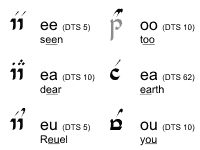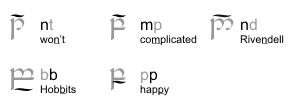There are two distinct methods with which the General Use is applied to the English language. One method is to follow the spelling used in the Roman alphabet, transliterating the numerous peculiarities of English orthography with fair accuracy. The other is to reproduce each sound of the spoken language, letting each tengwa represent an English phoneme. The two methods have on occasion been referred to as orthographic and phonemic spelling, and these terms will be used here.
As Tolkien points out,
There was of course no ‘mode’ for the representation of English. One adequate phonetically could be devised from the Fëanorian system. The brief example on the title-page [i.e. DTS 5] does not attempt to exhibit this. It is rather an example of what a man of Gondor might have produced, hesitating between the values of the letters familiar in his ‘mode’ and the traditional spelling of English. [AppE]
Since DTS 5 employs orthographic spelling, we may assume that this is generally what “a man of Gondor” would use. It is worth noting that the native tongue of Gondor, the Common Speech, apparently employed an orthography that did not always represent the pronunciation of the Third Age accurately. DM tells us that the Common Speech “had from its beginning been expressed in the Fëanorian Script”, and that writing with the Cirth was “dependent on the already established usages” of the Tengwar. The Dwarwes, who preferred the Cirth, used a spelling that was intentionally “a transcription of the current spelling of the Common Speech into Runic terms”, but this transcription was often incorrect in that many word were spelt phonetically — “for instance, letters that had in the colloquial pronunciation of the late Third Age ceased to have any function were sometimes omitted”. From this follows that the usual, correct spelling of the Common Speech — with Tengwar — included letters that were no longer pronounced. This is a clear parallel to what we here refer to as orthographic spelling.
If the orthographic spelling corresponds to “what a man of Gondor might have produced”, then perhaps we can assume that the phonemic spelling, on the other hand, is “adequate phonetically” as a mode designed specifically for English?
| Samples: DTS 5, DTS 10, DTS 11, DTS 62, DTS 68, DTS 84. |
|
|
The general rule of the English orthographic spelling is that each tengwa or tehta corresponds to a specific letter or sequence of letters in the Roman alphabet. However, on some points the system does not adhere strictly to Roman orthography. For instance, the voiced pronunciations of th and s ([ð] and [z]) are distinguished from their voiceless counterparts. In addition, the spelling sometimes deviates from the orthographic, in favor of a more accurate representation of the pronunciation. Thus the tehta for i can be used for the final vowel in history, and the tehta for o is used to represent the vowel in war.
Figure 1 lists the tengwar and their Roman letter equivalents. With each transcribed tengwa, at least one word is cited for which the letter has been used. The Roman letters that correspond to each tengwa in these words have been underlined. In cases where the tengwar represent a specific sound, the pronunciation of the tengwa is given in square brackets after the Roman-letter transcription. Tengwar whose transcriptions are marked with an asterisk (*) are not attested.
Figure 1: Tengwar for English orthographic spelling

Figure 2 lists the vowel-marks used. With each transcribed tehta, at least one word is cited for which the vowel-mark has been used. The Roman letters that correspond to each tehta in these words have been underlined.
Figure 2: Vowel tehtar for English orthographic spelling


Note that the underposed dot is used to indicate a “silent e”.
In DTS 10 the tehtar for i and e are
switched.

Double vowel characters in the Roman alphabet (i.e. the same vowel written twice) usually corresponds with doubled vowel tehtar. No use of the long carrier is attested in orthographic spelling.
Where two consecutive (different) vowel characters are used in the Roman alphabet, these may be transcribed as two consecutive tehtar. But the second vowel may also be represented by a suitable tengwa, as listed in Figure 1.
| Samples: DTS 36, DTS 37, DTS 39, DTS 47, DTS 56, DTS 58, DTS 70. |
|
|
Phonemic spelling has the disadvantage of requiring a rather detailed understanding of English phonology. It is probably also the spelling convention that is most likely to vary between speakers of different dialects of English, making it more difficult to understand for a larger audience.
Figure 3 lists the tengwar sound values for English phonemic spelling. With each transcribed tengwa, at least one word is cited for which the letter has been used. The Roman letters that correspond to each tengwa in these words have been underlined. Tengwar whose transcriptions are marked with an asterisk (*) are not attested.
Figure 3: Tengwar for English phonemic spelling

Figure 4 lists the vowel-marks used. With each transcribed tehta, at least one word is cited for which the vowel-mark has been used. The Roman letters that correspond to each tehta in these words have been underlined.
Figure 4: Vowel tehtar for English phonemic spelling


The samples indicate that short, unstressed vowels may sometimes be disregarded. Thus in DTS 39 the o in for is ignored, and in DTS 58, the second vowel in Rivendell is ignored.
 In DTS 36 and
37, the backward curl is used
for o instead of u. No u is attested in these samples,
but presumably it would be written with a forward curl.
In DTS 36 and
37, the backward curl is used
for o instead of u. No u is attested in these samples,
but presumably it would be written with a forward curl.

Only a few long vowels are found in the samples. The one attested long
/i:/ is written with a long carrier.
A long /u:/ is indicated by a doubled tehta.
Tengwar samples in other modes and languages suggest that the long carrier
may be used with all vowels, but that /u:/, /o:/
and /e:/ would often be doubled instead.

The samples of phonemic spelling for English testify the diphthongs
/ej/, /aj/, /ow/.
From these we can tell that front closing diphthongs (those ending in /j/)
are written with a vowel tehta and an anna, and
back closing diphthongs (those ending in /w/)
are written with a vowel tehta and a vala. It is not known how centring diphthongs
(those ending in /ə/) would be written; they probably did not play a crucial role in the dialect of
English written in Tengwar by Tolkien.
A superimposed horizontal line indicates a preceding nasal of the same series. In orthographic spelling only, a doubled Roman consonant letter is transcribed as a line below the baseline of the tengwa.

A following s is indicated by a hook extending downward. A following w may be indicated by the labial tehta. The latter is only attested in orthographic spelling, though it could conceivably be useful in phonemic spelling also.


The extended forms of the third series are occasionally used as optional variant letters. The samples are extremely scarce, but they might suggest that the extended forms are preferred in word-initial positions.

Shorthand forms are used for the common English words the, of, of the, and. The shorthands for the and of are based on the extended forms of the fourth series. A bar below the tengwa for of signifies of the.
In DTS 36 and 37, the o in of is written out. This should perhaps not be regarded as shorthand at all, but rather the extended form of ampa being used for the sound /v/.
The shorthand for and is written simply by omitting the vowel-sign of the word. In AppE, Tolkien describes the shorthand including the underposed dot as signifying an “unstressed” and.
Using either the orthographic or phonemic spelling, the following English texts may be written:
Orthographic spelling Phonemic spelling For the less even as for the greater there is some deed that he may accomplish but once only; and in that deed his heart shall rest.
— Feanor, in the Quenta Silmarillion.